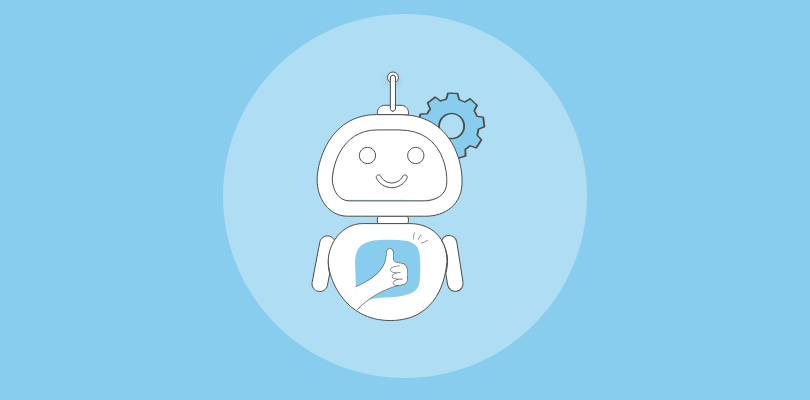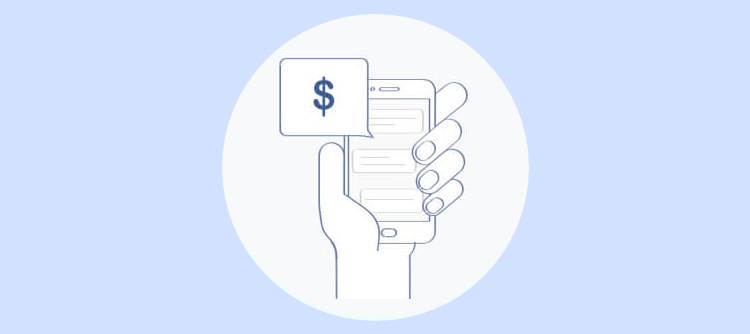“Automation is to your time what compounding interest is to your money.”
– Rory Vaden
Imagine a world where your customers are greeted by instant, round-the-clock service and personalized experiences that dazzle.
This isn’t a dream anymore; it’s the reality for businesses harnessing the power of chatbot automation.
This technological marvel, driven by advancements in artificial intelligence (AI) and machine learning (ML), has revolutionized the way companies interact with their customers, streamlining communication and enhancing user experience.
Wish to know more about automation in chats?
Here, I have brought a detailed guide on chatbot automation with its best features, as well as some advanced chatbot automation software to assist you.
Let’s dive right in!
What is Chatbot Automation?
Chatbot automation involves using software applications to perform automated tasks and engage with users through conversational interfaces, typically without human intervention.
These chatbots are programmed to understand and respond to text or voice commands, facilitating tasks ranging from customer service inquiries to scheduling appointments.
Let’s see an example:
A retail company might use chatbot automation tools on its website to assist customers in tracking orders, answering FAQs, or even providing personalized shopping recommendations 24/7. This not only enhances the customer experience by providing instant responses but also streamlines the company’s operations by handling routine inquiries efficiently.
Benefits of Chatbot Automation
Chatbot automation is reshaping customer service, lead generation, and business operations by providing a lot of benefits that enhance efficiency, customer satisfaction, and operational insights.
Here are some of the major benefits:
1. 24/7 Availability
Chatbots are tirelessly at work, offering round-the-clock assistance to users worldwide. This non-stop availability ensures that businesses can cater to customers across different time zones without delay.
For instance, HSBC’s chatbot, Amy, can answer banking inquiries any time of the day, significantly improving customer experience by providing instant support outside of traditional banking hours.
2. Cost Reduction
By automating routine customer service queries, chatbots can drastically cut down on operational costs. This automation reduces the need for a large customer service team to handle basic inquiries, thereby saving on labor costs.
According to IBM, businesses can reduce customer service costs by up to 30% by implementing chatbot solutions, demonstrating the significant financial impact of chatbot automation.
3. Handling Capacity
Chatbots can handle numerous conversations simultaneously, ensuring that no customer message goes unanswered. This scalability is particularly crucial during peak times or events when the volume of inquiries spikes.
For example, Domino’s Pizza uses its chatbot to handle orders efficiently, allowing customers to place orders through a conversational interface without the need for human intervention, even during busy periods.
4. Consistency in Responses
Chatbots eliminate the variability in answers that can occur with human agents by providing standardized responses to frequently asked questions. This consistency ensures that all customers receive the same level of information and service quality. It’s like having a customer service manual that never deviates from the script, ensuring reliability in the information provided.
Read More: Chatbot Scripts: What it is & How to Make Your Scripts [+Examples]
5. Personalization
Through advanced algorithms and data analysis, chatbots can tailor conversations and recommendations to the individual user, offering a more personalized interaction. This personal touch can significantly enhance the customer experience.
Sephora’s chatbot, for instance, suggests products based on the user’s past purchases and preferences, creating a more curated shopping experience that feels bespoke and individualized.
6. Improved Customer Engagement
Chatbots can initiate conversations with customers, offering them information and recommendations proactively. This engagement can make the customer feel valued and can lead to increased loyalty and sales.
Nike’s chatbot, for example, engages customers by offering personalized training plans and product recommendations, thereby enhancing the customer’s interaction with the brand beyond a simple transaction.
7. Analytics and Insights
The data collected from chatbot interactions provides valuable insights into customer preferences and behaviors. This information can be instrumental in refining products, services, and customer interactions. By analyzing chatbot conversations, businesses can identify common customer issues, preferences, and trends, allowing them to adapt their offerings to meet customer needs better.
8. Multilingual Support
Chatbots can interact with customers in multiple languages, breaking down language barriers and making services accessible to a broader audience. This capability allows businesses to expand their reach and cater to a global customer base without the need for extensive multilingual staff.
For instance, airlines like KLM use chatbots to offer customer support in several languages, making it easier for international travelers to receive flight information and assistance in their native language.
Chatbot Automation Use Cases in Different Industries
Chatbot automation is transforming a wide range of industries by streamlining operations, enhancing customer experiences, and providing actionable insights.
Here are some use cases across different sectors, showcasing the versatility and impact of chatbots:
1. Retail
Chatbots in retail act as personal shopping assistants, offering product recommendations, answering inquiries about product availability, and facilitating the purchasing process.
For example, H&M’s chatbot on Kik helps customers find and purchase products based on their style preferences. Although specific transaction numbers aren’t publicly available, it’s a prime example of how chatbots can enhance the shopping experience and potentially increase sales conversions, aligning with the Juniper Research forecast that chatbot interactions could generate $112 billion in retail sales by 2023.
2. Healthcare

In healthcare, chatbot use cases include scheduling appointments, sending reminders for upcoming visits or medication intakes, and providing preliminary health consultations based on patient-described symptoms.
For example, Babylon Health’s chatbot offers medical consultations and has been reported to accurately assess symptoms with an 80% accuracy rate, according to Digital Health. This level of accuracy in symptom assessment showcases the chatbot’s potential to improve efficiency and patient care in the healthcare industry.
Read: Use Cases of Healthcare Chatbots: A Detailed Guide 2025
3. Finance

Financial institutions use chatbots for a range of customer service tasks, including checking account balances, transferring money, and providing information on products and services.
For example, Bank of America’s Erica has served over 25 million users, assisting with banking transactions, credit report updates, and bill payments. This example highlights the scale and effectiveness of chatbots in enhancing customer service and operational efficiency in the financial sector.
4. Hospitality
In the hospitality industry, chatbots are used for booking rooms, answering customer inquiries, providing recommendations for local attractions, and handling complaints or requests during stays.
For example, Marriott International’s chatbot has engaged in over 1.5 million conversations, aiding in room bookings and offering local travel tips. This level of engagement demonstrates how chatbots can significantly improve customer service and streamline the booking process in the hospitality industry.
5. Education

Educational institutions are leveraging chatbots for administrative tasks, student support, and campus information, as well as as a tool for learning and engagement. A chatbot for education can assist with answering student queries, providing academic resources, and enhancing overall engagement.
For example, Georgia State University‘s Pounce chatbot helped reduce summer melt by 21%, answering questions about enrollment processes, financial aid, and registration. This reduction in summer melt highlights the chatbot’s effectiveness in supporting students through critical administrative hurdles and improving enrollment rates.
Also Read: 14 Convincing Benefits of Live Chat for eCommerce
Top Features in Automated Chatbot Software
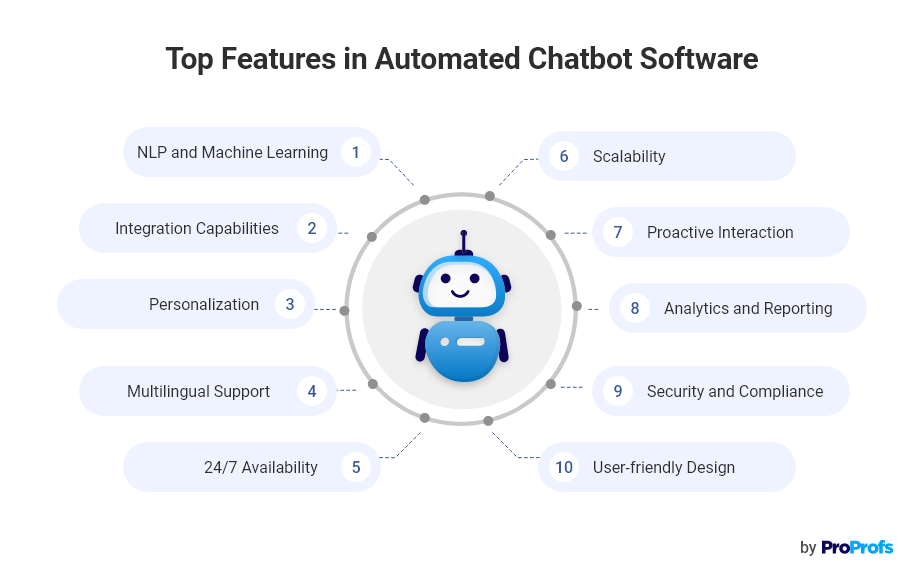
The best features of automated chatbot software are as follows:
- Natural Language Processing (NLP) and Machine Learning: These technologies enable chatbots to understand and interpret human language more accurately, allowing for more natural and intuitive conversations. Over time, the automated chatbot for websites can learn from interactions to improve its responses and effectiveness.
- Integration Capabilities: The ability to integrate with various platforms (like social media, messaging apps, and company databases) and software systems (such as CRM, ERP, and helpdesk software) allows chatbots to pull in necessary information and perform actions across different systems, providing a seamless experience for the user.
- Personalization: Personalizing interactions by using the user’s name, recognizing past interactions, and tailoring recommendations based on user data and behavior make conversations more engaging and can significantly enhance customer satisfaction.
- Multilingual Support: The ability to converse in multiple languages broadens the reach of chatbots, making them accessible to a wider audience and improving the customer experience for non-English speakers.
- 24/7 Availability: One of the primary benefits of automated chatbots is their ability to provide instant responses at any time of the day, ensuring that customer inquiries are addressed promptly, even outside of regular business hours.
- Scalability: Chatbots can handle a large number of interactions simultaneously, scaling as demand increases without the need for proportional increases in support staff.
- Proactive Interaction: Advanced chatbots can initiate conversations based on certain triggers or behaviors, such as a user visiting a particular page on a website. This proactive approach can enhance engagement and lead to higher conversion rates.
- Analytics and Reporting: The ability to track interactions and analyze data is crucial for understanding customer needs, identifying areas for improvement, and measuring the chatbot’s performance and ROI.
- Security and Compliance: Ensuring data privacy and security, especially for industries like law firms that deal with sensitive information, is crucial. Compliance with regulations such as GDPR is a must-have feature for chatbots.
- User-friendly Design and Customization: An intuitive design and the ability to customize the chatbot’s appearance and conversational style can greatly enhance user experience and align the chatbot with the brand’s identity.
Also Read: 12 Essential Chatbot Features to Consider in 2025
FREE. All Features. FOREVER!
Try our Forever FREE account with all premium features!
Top 5 Automated Chatbot Software
Here is a list of some of the best and most popular automated chatbot software that I’ve used in the last few years. Check out their pricing and features to get a better idea:
1. ProProfs Chat
Best for 24/7 Customer Support With AI Chatbots
In my experience, ProProfs Chat shines brightest for organizations aiming to offer round-the-clock customer support through AI chatbots.
This tool stands out for its brilliant fusion of AI-driven chatbots and human support capabilities, creating a support experience that feels both intelligent and genuinely personal. What I particularly admire about ProProfs Chat is its intuitive design, which makes it incredibly easy for our team to manage conversations, even during peak traffic times.
Besides, the flexibility to seamlessly escalate more complex issues to human agents ensures that every customer interaction is handled with the care it deserves. ProProfs Chat has been a transformative force in approaching customer support, making it an indispensable asset for businesses in customer service.
What You Will Like:
- Seamless integration capabilities with a wide array of CRM and helpdesk tools, enhancing your support infrastructure.
- Advanced analytics and reporting features that provide deep insights into customer interactions and satisfaction levels.
- Chatbots can be customized to align with your brand’s aesthetics, offering a consistent user experience.
- Capable of managing numerous conversations simultaneously, making it highly efficient for busy periods.
- Smart triggers to proactively engage customers based on their behavior on your website, improving engagement rates.
What You May Not Like:
- Although the free plan offers all premium features, it’s limited to a single operator.
- The AI chatbots may experience updates with time.
Cost: Forever free for a single operator. Paid plan starts at $19.99/operator/month.
2. Zendesk
Best for Zendesk Users
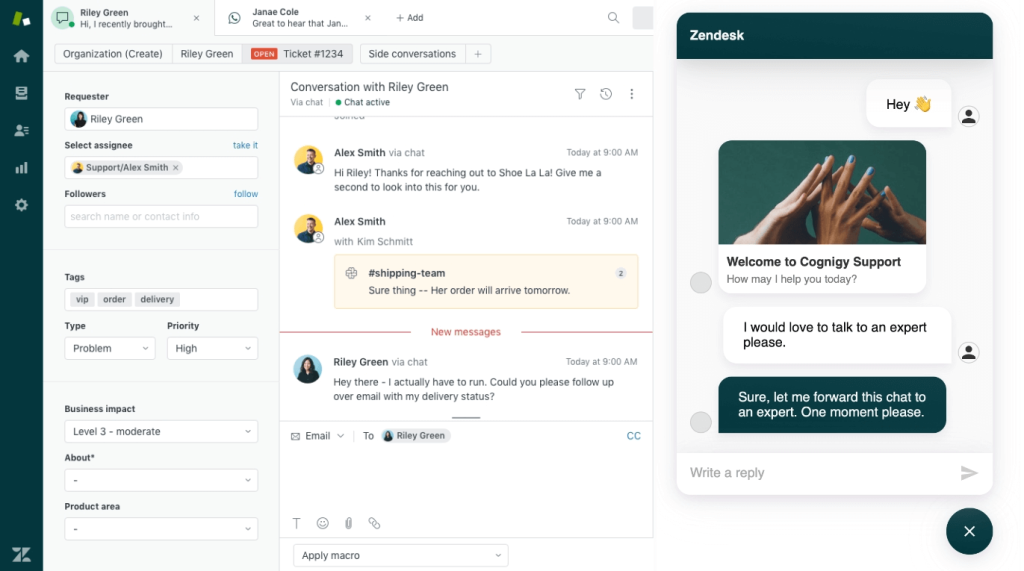
Having spent considerable time navigating various customer support tools, I’ve found Zendesk to be particularly invaluable for those already entrenched in the Zendesk ecosystem. Its seamless integration into existing Zendesk solutions is a game-changer.
From ticketing to knowledge bases, everything feels interconnected, streamlining the support process in ways I hadn’t experienced before. The interface is intuitive, which significantly reduces the learning curve for new team members, allowing them to dive right into providing stellar customer service without missing a beat.
What makes Zendesk stand out as a chat automation tool is its robust automation and AI capabilities. These features have been a boon, enabling us to automate responses to common inquiries, which not only speeds up resolution times but also allows our support staff to focus on more complex issues.
What You Will Like:
- Easily integrates with social media platforms, allowing you to extend your customer service efforts to where your customers are most active.
- Provides detailed analytics that helps you track and measure customer satisfaction and agent performance.
- AI-powered automated responses are available to provide instant support, reducing wait times for customers.
- Highly customizable chat interface that enables businesses to create a seamless brand experience across all support channels.
- An efficient ticketing system that organizes customer issues, streamlining the resolution process.
What You May Not Like:
- Non-technical users may face a higher learning curve when utilizing all of Zendesk’s features fully.
- Some of the software’s integrations require additional subscriptions, adding to the overall cost.
Cost: Starts at $55/agent/month. Billed annually.
Also Read: Zendesk Alternatives: 10 Best Customer Support Software in 2025
3. Intercom
Best for Omnichannel Platform with Messenger and App
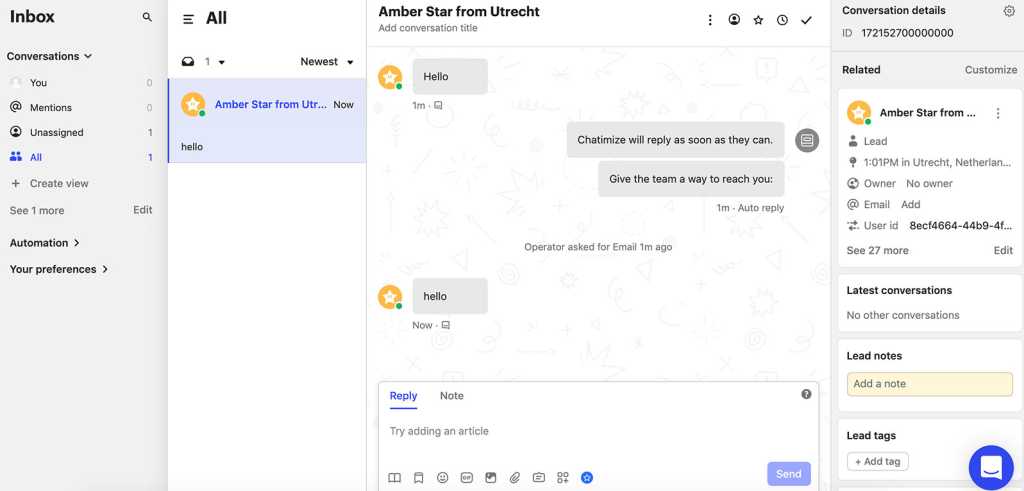
Intercom has transformed the way I engage with customers across multiple channels. What sets it apart is its comprehensive omnichannel platform, which includes a state-of-the-art messenger and app that facilitate smooth interactions whether customers are on our website, in our mobile app, or reaching out via social media.
This versatility has been crucial in maintaining consistent and personalized communication with our users, regardless of their preferred touchpoint. The tool’s strength lies in its ability to offer a unified view of the customer, capturing every interaction in a single thread.
This not only ensures that we’re always up to speed on each customer’s history but also allows us to deliver a cohesive experience. Intercom’s messenger is particularly impressive, equipped with chatbots that can handle an array of tasks, from answering FAQs to guiding users through processes, effectively reducing response times and enhancing customer satisfaction.
What You Will Like:
- Allows for personalized engagement strategies, ensuring that customer interactions are tailored and relevant.
- Offers robust user segmentation, enabling targeted support and marketing initiatives.
- A comprehensive analytics dashboard that gives clear insights into customer behavior and support effectiveness.
- Chatbot workflows can be customized to meet specific business requirements, enhancing the utility of automated responses.
- Intercom supports a high level of chat interface customization, ensuring consistency with your brand’s look and feel.
What You May Not Like:
- Compared to competitors, it offers limited options for integration with third-party services.
- Customizing chatbot scripts to match your business’s tone and requirements perfectly can be a complex and time-consuming process.
Cost: Starts at $39/seat/month.
Must Read: 11 Best Intercom Alternatives & Competitors [REVIEWED]
4. Chatbot
Best for Small and Medium-Sized Enterprises (SMEs)
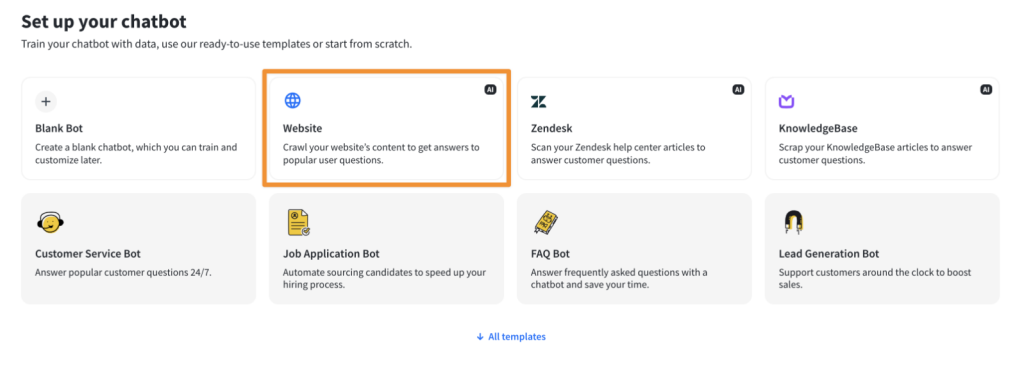
For SMEs operating with limited resources, Chatbot democratizes access to advanced AI technology, allowing us to deploy chatbots that can engage with customers, answer their questions, and guide them through their journey on our website.
I really like how it makes sophisticated technology accessible without requiring extensive technical expertise. The interface is intuitive, and setting up a bot is straightforward, making it possible to improve our customer service without a significant investment in time or money.
Also, its flexibility means we can tailor our bots to meet specific business needs, whether that’s capturing leads, providing 24/7 customer support, or offering personalized recommendations.
What You Will Like:
- Provides pre-built templates that significantly speed up the chatbot creation process, allowing quick implementation.
- Direct integrations with e-commerce and social media platforms to enable businesses to provide support where their customers are active.
- Comprehensive analytics are available to track the performance of chatbots, offering insights into customer interactions and satisfaction.
- A dedicated support team is on hand to assist with any issues, ensuring smooth operation and quick resolution of queries.
- The platform’s focus on ease of use does not sacrifice functionality, providing SMEs with powerful tools to enhance customer service.
What You May Not Like:
- Setting up a chatbot in various languages is not straightforward and requires manual effort to duplicate and translate content.
- The platform does not support sending broadcasts and sequences, which means it cannot initiate conversations with users; it only responds when a user initiates the interaction.
Cost: Starts at $52/month. Billed annually.
5. LivePerson
Best for Text-Based Communication Channels
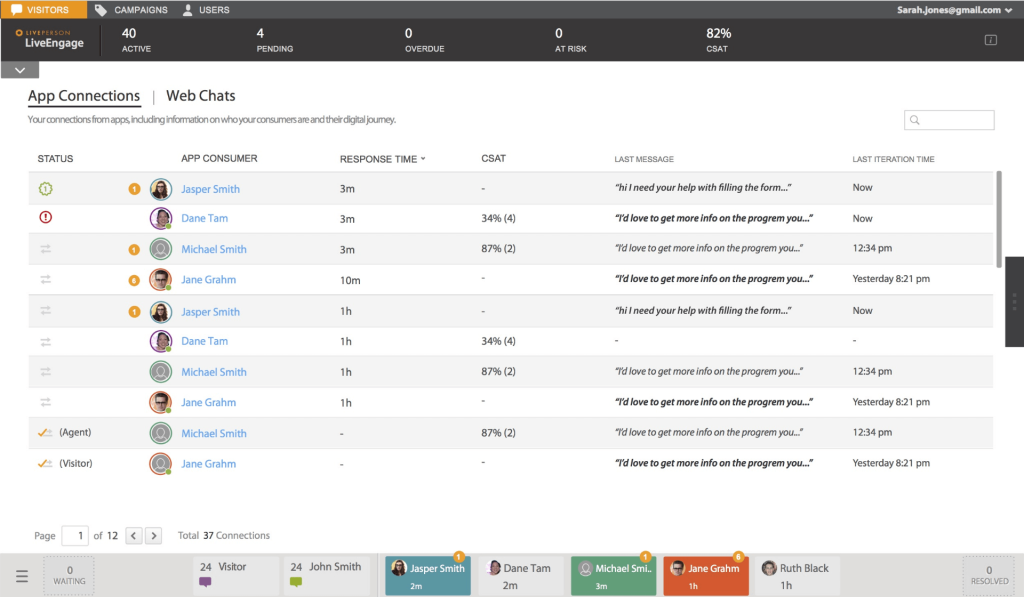
LivePerson has been instrumental in elevating my customer communication strategy, especially through text-based channels. Its platform excels in understanding and mimicking human conversation thanks to its cutting-edge AI.
This capability has enabled the team to offer personalized, context-aware support across various messaging platforms, from SMS and WhatsApp to web chat. The chatbot doesn’t just respond to queries; it anticipates customer needs, offering solutions and information proactively.
This level of engagement has significantly enhanced customer satisfaction and loyalty, making every conversation feel genuinely personal and impactful.
What You Will Like:
- The platform integrates with all major messaging applications, ensuring you can reach your customers no matter where they are.
- Uses AI to analyze customer intent, allowing for more effective and personalized communication.
- Messaging interfaces can be customized to reflect your brand, creating a cohesive customer experience across all touchpoints.
- High-level security measures are in place to protect customer data and privacy.
- Detailed analytics provide insights into how customers interact with your brand, enabling continuous optimization of your communication strategies.
What You May Not Like:
- Setting up chat engagements and campaigns can be confusing due to the multiple levels of configurations required.
- The options for exporting chat transcripts from LivePerson are limited, which could be inconvenient for businesses that need to analyze or archive these interactions extensively.
Cost: Custom pricing.
Read: 8 Best LivePerson Alternatives to Boost Your Engagement in 2025
Embracing Chatbot Automation for Enhanced Efficiency
To sum it up, it’s clear that the landscape of chatbot automation is vibrant, promising, and ever-evolving. You can use advanced tools like ProProfs Chat for seamless user interactions and nuanced conversational flows, ensuring enhanced engagement and efficiency.
The journey into automating customer service or enhancing user engagement through chatbots is not just a leap into the future; it’s a stride towards revolutionizing communication.
So, I think these digital companions can unlock new realms of efficiency and personalization to help you manage your sales and customer support better.
Learn More About Chatbot Automation
What types of businesses can benefit the most from implementing chatbot automation?
Businesses that engage in high volumes of customer interactions stand to benefit the most from implementing chatbot automation. This includes sectors like retail, banking, telecommunications, and various service industries. Chatbots efficiently manage routine inquiries and transactions, allowing human agents to concentrate on more complex or sensitive issues. This enhances the customer experience by reducing wait times and improving operational efficiency.
What role does artificial intelligence (AI) play in chatbot automation?
Artificial Intelligence (AI) plays a crucial role in the functionality and effectiveness of chatbot automation. Using natural language processing (NLP), AI enables chatbots to comprehend and interpret human language, allowing for more natural and engaging conversations. AI-driven chatbots can learn from past interactions to improve their responses over time, and they can offer personalized experiences by anticipating user needs based on historical data.
What are some common misconceptions about chatbot automation?
One common misconception about chatbot automation is that chatbots are capable of fully replacing human customer support, rendering human agents obsolete. But chatbots are more accurately viewed as a complement to human support, handling routine inquiries while escalating more complex issues to humans. Another misconception is that chatbots lack the sophistication to understand or resolve complex queries. While it's true that human intervention is still necessary for nuanced issues, advancements in AI and machine learning have vastly improved chatbots' understanding capabilities.
Also Read: 15+ Best Customer Service Automation Software for 2025
 Tips
Tips
We’d love to hear your tips & suggestions on this article!
FREE. All Features. FOREVER!
Try our Forever FREE account with all premium features!


 We'd love your feedback!
We'd love your feedback! Thanks for your feedback!
Thanks for your feedback!



